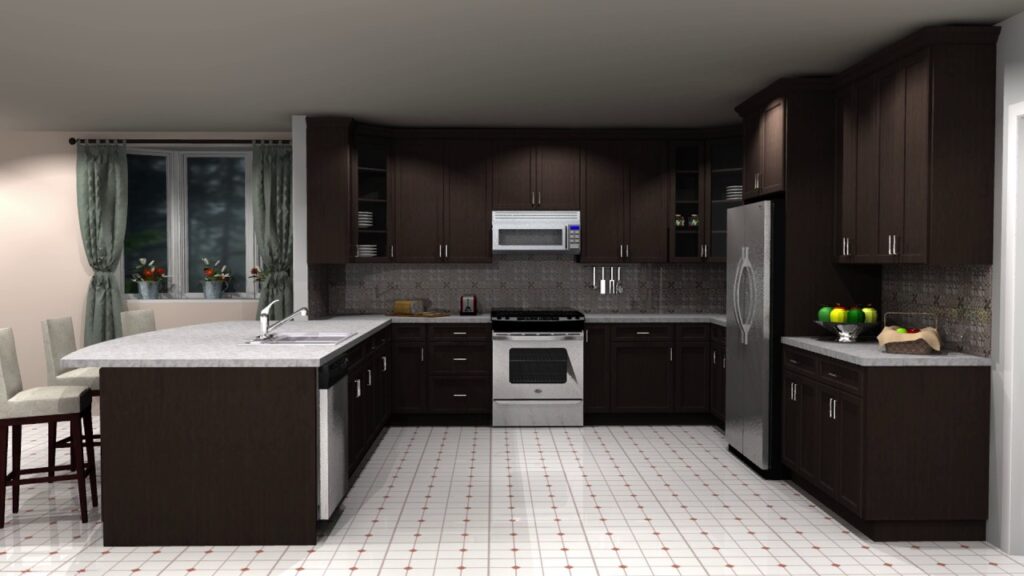You may be wondering how to design your kitchen cabinet layout. There are many options to choose from, including the G-shaped, the One Wall Kitchen, and the Galley layout. Here are some tips to help you decide on the best layout for your home. After deciding on a layout, start measuring the space you have to maximize the number of cabinet doors and drawers. You should also consider the size of your appliances to determine how much space you need for storage.
G-shaped kitchen
A G-shaped kitchen is a flexible layout for a small or large space. The peninsula worktop is an excellent addition to this kitchen, and the extra space can be used to store appliances, a dishwasher, or even a basement. These layouts also provide additional seating options. For a practical and stylish kitchen, a G-shaped layout is the best choice. Here are some pros and cons of the G-shaped kitchen cabinet layout.
The G-shaped layout has many advantages, including more storage space than any other design. Unlike other kitchen cabinet layouts, a G-shaped kitchen design requires careful planning. Consider adding a corner cabinet for more space in the corner, or a tall cabinet to store larger items. Experiment with storage design until you find the right combination for your space. You’ll be glad you did! This kitchen layout requires some thought before you begin.
A G-shaped kitchen design is perfect if your cabinets are tall. While you’ll have more storage space, you’ll have extra counter space on the peninsula. You can even use that fourth wall for a breakfast bar or a buffet area. It’s up to you how you decide to use the additional space! If you don’t like a traditional breakfast bar, you can choose a G-shaped layout that accommodates that.
While the G-shaped kitchen cabinet layout may look crowded and cramped, there are plenty of possibilities for creative design solutions. Depending on the style and function of your kitchen, you can use creative splashback ideas, accessories, and paint. You can choose to use a combination of colors and textures, but you must remember that light colours will make your kitchen appear airier and more spacious. A G-shaped kitchen also requires a variety of top units. Using identical top cupboards may seem cramped and reduce the space.
A medium-sized kitchen is ideal for two cooks. You can also extend out the kitchen to create extra storage space and keep the work triangle in place. To maximize storage space, place your refrigerator near the walkway entrance. Keep the door to your refrigerator facing the work space. If you have room in your kitchen, consider adding a peninsula, which provides extra counter space and lower cabinet storage. You can also consider extending the G-shaped kitchen layout outward to accommodate extra base cabinets and a peninsula for dining or entertaining.
A G-shaped kitchen has many benefits over a U-shaped kitchen. It maximizes the floor space with worktops on both sides, and a breakfast bar. The G-shaped design also offers an open space for family members to congregate. A G-shaped kitchen is great for families that entertain often and like to have plenty of space for prep areas. If you’re planning a large family dinner, this design is the ideal choice.
One Wall Kitchen
One wall kitchens can be quite stylish. They are ideal for studio apartments, as the layout takes up very little space and has a sleek appearance. These kitchens usually feature black lower cabinets that contrast with the light-colored granite countertop. The upper cabinets feature frosted glass doors to show off your dinnerware. You can also add a simple island with high chairs for a cozy breakfast area. Alternatively, you can opt for wood flooring or a red-patterned carpet.
One wall kitchens are ideal for people with busy lifestyles. They provide the essential services without compromising living space. They can accommodate a number of cabinets and overhead cabinets. This layout also allows you to incorporate open shelves to maximize storage space. This layout is extremely flexible and can accommodate a variety of cabinet styles. For more ideas, contact an architect. You’ll be glad you did. They will be able to guide you through the entire process.
A one wall kitchen design eliminates the need for a work triangle in a traditional kitchen. The main countertop, sink, and appliances are all located along one wall, making it easier for you to move from one area to the next. This layout also minimizes construction costs because it only requires one bank of cabinets. The lower number of cabinets means lower prices. And the lower total cost also means more kitchen storage! It’s time to take a closer look at one wall kitchens.
Another way to make a one wall kitchen functional and beautiful is to incorporate multi-purpose furniture. A drop-down table is perfect for serving meals, or doubles as a work counter. Additionally, a kitchen island can provide additional seating space. There are several types of islands, such as movable or built-in, which can also be a great addition to your kitchen. So, what’s the best one-wall kitchen layout for you?
When comparing one wall kitchen layouts, it’s important to keep the three major work zones in mind. One wall kitchen layouts eliminate the need for a separate prep area, so you can keep everything together. Creating the perfect kitchen isn’t always easy if you don’t know how to set it up, so a one wall kitchen can make the process a little easier. With these kitchen plans, you’ll be able to use all of your space efficiently without compromising style.
In addition to maximizing storage space in a one-wall kitchen, you can also add a kitchen island or a pantry. Although there are several types of kitchen pantries, most of them are flexible and customizable. When planning a kitchen island, consider the placement of the other appliances. You’ll need to take into account the space that will be taken up by these two appliances. You should also consider where you’re going to place the refrigerator and dishwasher.
Galley kitchen
When planning a kitchen, make sure to keep the space in mind and minimize clutter. A galley kitchen can look cramped and unorganized, but with the right cabinet layout, you can pack plenty of storage into a small space. If possible, use pull-outs or dividers to keep your kitchen clutter-free. Also, opt for a built-in microwave drawer rather than displaying it on the counter. If you have extra countertop space, consider using tall storage to hide items that are rarely used.
Having a feature wall on one side of the kitchen can make the space look more spacious. In contrast, a plain white wall with no design can create the opposite effect. You can also add open kitchen shelving, as opposed to wall cabinets. However, if you are messy, you may not want to opt for this option. Alternatively, installing a kitchen island can help create a more pleasant working environment.
Asymmetrical kitchens are also possible, and have several advantages. For example, you can create a dining area by utilizing the extra space on either side of the kitchen. You can also create more room by using different lengths of countertops. You can also create a small dining area if you install glass doors at the end of the kitchen. Asymmetrical galleys can also make a kitchen look larger.
When designing a kitchen, you can add a touch of fun and energy. Use complementary colours to make the space feel lively and inviting. Incorporate coordinating cabinetry to enhance the overall look. Try a light shade in the corner near the window to emphasize brightness, and a darker shade in the window opposite to highlight metallic hardware. Finally, add a center piece of lighting to finish the look. These kitchens are a great way to create a more spacious and cozy atmosphere.
The most effective galley kitchens include a breakfast bar, open shelving, and a large window. The traditional triangle is equilateral, with arms of equal length. A galley kitchen has too narrow an area to accommodate a work triangle of this type. You’ll have to make an exception to fit the work triangle in a kitchen with an irregular shape. Instead, place a single element on the opposite wall. This has been proven to be the most efficient work arrangement.
A traditional galley kitchen consists of two parallel runs of units that form a central corridor. Typically, the kitchen elements are located on one or both sides of the corridor. Some homeowners choose to intersperse countertops with appliances and other equipment. These kitchen designs maximize the space available, making them a great choice for small spaces. A galley kitchen can be quite cramped, so choosing the right layout is important to maximize its space.

